As part of Studiosity’s annual Student Wellbeing Survey, YouthInsight asked University students from Australia and New Zealand about their study-related stress and how they balanced their studies and other life priorities.
Here is a round-up of the key insights from Chapter 1: Students’ Experiences of Stress & Priorities (2022 – 2023 Australian and New Zealand Student Wellbeing Survey).
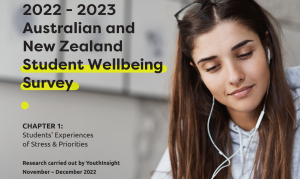
KEY INSIGHTS
- Stress continues to impact students: 7 out of 10 participants reported being stressed at least once per week, a continued trend from our 2021 survey (74%). 1 in 5 students feel stressed daily, with women significantly more likely to report feeling stressed “constantly”.
- Students are increasingly balancing full-time study with paid employment (84%): 86% of Australian students work while studying (up from 78% in 2021).
- Students continue to aim high and achieve their grade aspirations: a Distinction grade is most common (39%).
During the pandemic, research showed that university students presented with higher levels of stress compared to pre-pandemic levels. Today, it is vital to understand the experiences of university students’ stress in a post-pandemic world, ensuring that we establish robust supports during their learning journey as they increasingly balance employment, social, extracurricular, and family and carer commitments.
Stress continues to impact students
Of 1,137* university students across Australia and New Zealand who took part in the Student Wellbeing Study, 72% of students reported being stressed by their studies on a weekly or more frequent basis. This outcome is in line with 2021 survey results (74%) but slightly lower than 2019 (77%). Today, women are significantly more likely to report feeling stressed “constantly”, almost double the rate of men who feel the same way (20% vs 11%).
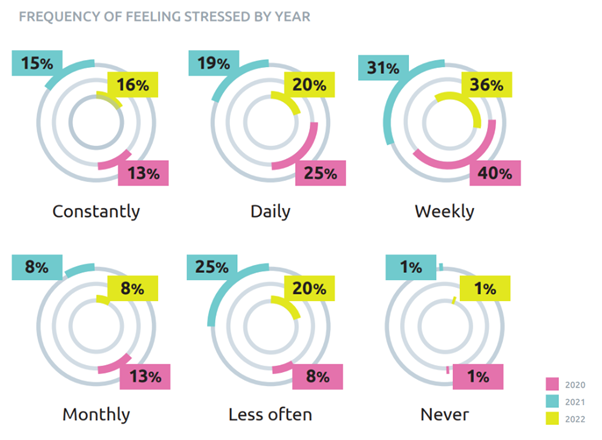
Q. On average, how often do you feel stressed by studying?**
Causes of stress
- The number 1 source of stress for students (66%) is balancing study time with other responsibilities and commitments (including employment, social and extracurricular commitments).
- This issue is particularly stressful for women (72%), part-time students (76%), culturally and linguistically diverse (CALD) students (70%), and for those who are working during their studies (70%).
- High workload of studying is reported as the second most common stressor (52% – up from 49% in 2021), with younger students aged 18-23 more likely to be stressed by the high workload (56%) compared to older students aged 24+ (46%).
- Though younger students are more likely to be stressed by difficult course content (32% vs 21% of older students), they are less stressed by referencing (10%) compared to students aged 30+ (with 23% of these participants placing it in the number 3 position). An important takeaway for academic literacy and study support provided to this cohort of students at university.
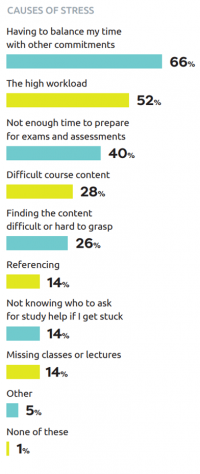
Q. Out of the following options, what makes you feel the most stressed about studying?**
Less than half of all students prioritise socialising
When asked about how they would like to prioritise their time, 8 out of 10 students reported that their preference is study. This is followed by paid work (7 in 10 students), highlighting the importance for students to generate income during their time at university.
Particularly, paid work is of relatively higher priority for part-time students (35% vs. 19% of full-time students), regional and rural students (32% vs. 21% of metro students), and non-CALD students (25% vs. 17% of CALD students).
Interestingly, less than half of all students listed socialising in their top three priorities (46%), again buttressing other life, work and study commitments as being of a higher priority.
Though caring for family members was ranked as a top 3 priority by 47% of students, among those with caring responsibilities 89% placed this in their top 3, and 47% reported this was their number 1 priority. Challenges faced in balancing study time and other responsibilities are more evident for older students.
Want for connection correlates with feelings of stress
Qualitative data about stress frequently mentioned time, study workload and other commitments. Want for connection with other students was correlated with feelings of stress, with those who said that they would like to connect with students being more stressed more often (74% feel stressed weekly or more) compared to 66% who are happy with their level of connection with other students.
KEY TAKEAWAYS
- With over 80% of students working while studying, it is vital that the Higher Education sector evaluates how it can better support students in balancing their work and study commitments. This might be the reevaluation of study workloads, or considerations for expanding scholarships to better support students in their prioritisation of study (with 8 out of 10 students reporting that they would like to prioritise their study).
- Though students continue to aim high and achieve their grade aspirations, stress frequency is experienced differently by students who achieve a Credit, D or HD grade (significantly less likely to feel stress weekly or more – 70%) vs students who achieved a Pass or Non-Pass (79%). Here, the sector needs to review how they can better support students across all levels of academic attainment to alleviate stress, but especially students achieving a Pass or a Non-Pass grade.
- Students wanting a connection with their peers correlated with higher stress frequency (74% feel stressed weekly or more) compared to 66% who are happy with their level of connection with other students. More focus is needed to better support students’ connection with their peers, possibly through social events or other opportunities where students can connect both inside and outside of the classroom.
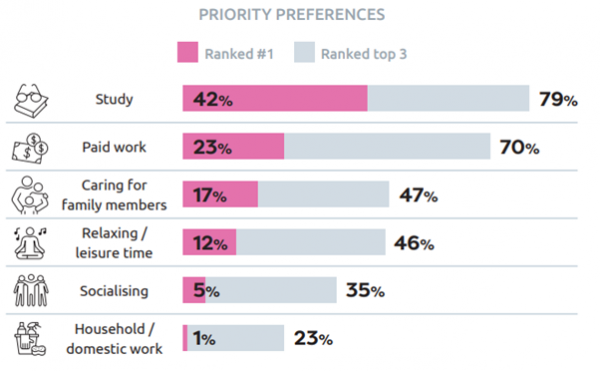
Q. If you could choose, how would you prioritise the following, in terms of how you would spend your time?**
*The survey ran from 14th November to 6th December 2022 and gained a total of 1,137 responses, of which 995 were in Australia, while 142 were in New Zealand. All Australian public universities were represented in the Australian sample. In New Zealand, all universities were represented.
**Data charts sourced from Chapter 1: ‘Student experiences of stress and their priorities’ report.




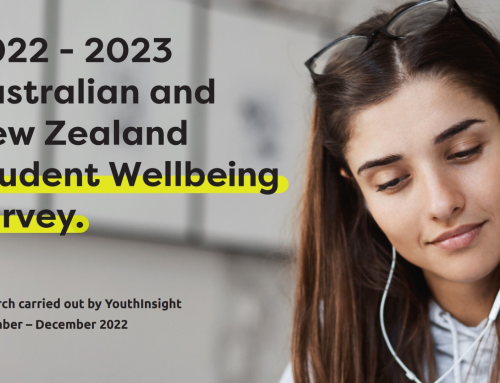




[…] Denejkina, A. (2023). University Students’ Stress & Priorities. [online] YouthInsight. Available at: https://youthinsight.com.au/education/university-students-experiences-of-stress-priorities/. […]